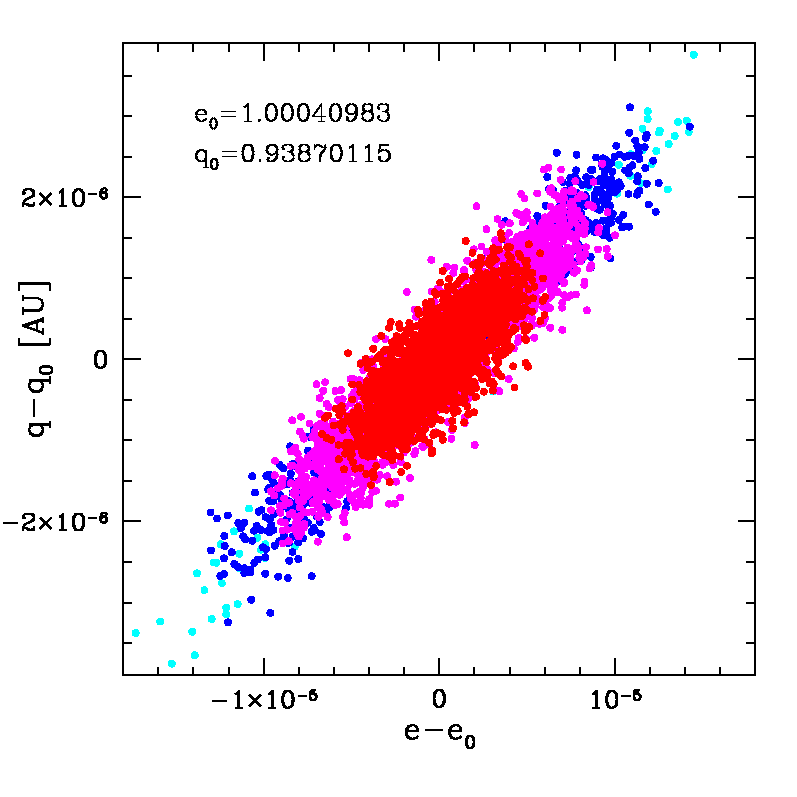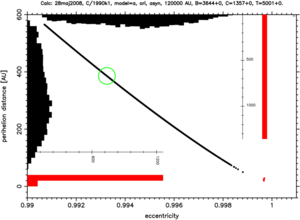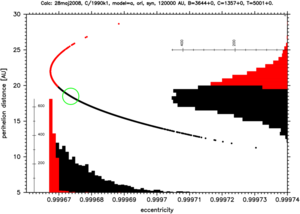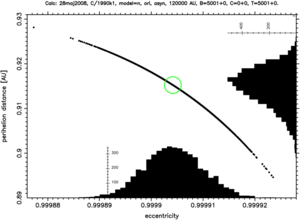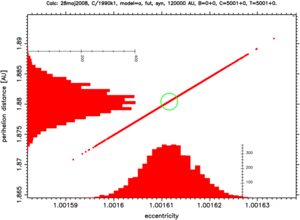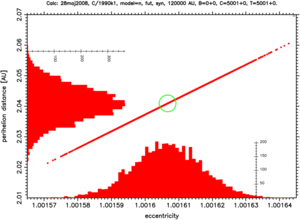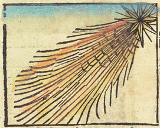Nongravitational nominal solution
Observational arc: 1990 05 21 - 1992 04 01 Number of observations: 678 RMS: 1.05 arcsec (1323 residuals used, 2.4% rejected residuals )
Heliocentric osculating orbit
Epoch Perihelion time q e ω Ω i
1990 11 05 19901024.684002 0.93870115 1.00040983 242.665517 139.364408 131.582216
± 0.000055 0.00000098 0.00000441 0.000027 0.000026 0.000062
NG parameters:
A1 = (3.3077 ± 0.0896 )×10-8 AU/day2
A2 = (0.09735 ± 0.04212)×10-8 AU/day2
A3 = (0.34666 ± 0.01289)×10-8 AU/day2
Barycentric nominal original orbit (at 250 AU from the Sun)
Epoch Perihelion time q e ω Ω i
1691 07 15 19901024.552902 0.93928719 0.99990165 242.649942 140.000411 131.568927
± 0.000161 0.00000302 0.00000537 0.000320 0.000024 0.000062
1/aori = (+104.71 ± 5.72)×10-6 AU-1
Barycentric nominal future orbit (at 250 AU from the Sun)
Epoch Perihelion time q e ω Ω i
2280 07 07 19901025.271800 0.93079363 1.00073287 242.438614 140.018152 131.500579
± 0.000144 0.00000185 0.00000268 0.000124 0.000043 0.000062
1/afut = (-787.37 ± 2.88)×10-6 AU-1
In the 17th edition of the Catalogue of Cometary orbits (2008):
Nongravitational orbit (314 obs.) with A1 = 3.0 ×10-8 AU/day2 and A2 = -0.2 ×10-8 AU/day2.
The same comet in some other internet sources:
More details
Starting swarms of VCs...(heliocentric, osculating orbits)
Original and future orbit at the 250 AU from the Sun.
Comet number 13 in the Table: Nongravitational Oort spike comets (26 objects)
| Name | GR (1/a)ori [10-8 AU/day2] | GR (1/a)osc [10-8 AU/day2] epoch [TT] | GR 1/afut [10-8 AU/day2] | RMSGR [arcsec] | NG (1/a)ori [10-8 AU/day2] | NG (1/a)osc [10-8 AU/day2] epoch [TT] | NG 1/afut [10-8 AU/day2] | RMSNG [arcsec] | NG parameters A1 A2 A3 [10-8 AU/day2] tau shift [day] | |
| 13 | C/1990 K1 Levy weighting | +17.59 ± 1.70 | -622.39 ± 1.72 1990 11 05 | -857.12 ± 1.71 | 1.71 | +104.71 ± 5.72 | -436.59 ± 4.70 1990 11 05 | -787.37 ± 2.88 | 1.05 | 3.3077 ± 0.0896 0.09735 ± 0.04212 0.34667 ± 0.01289 |
Note: in the following plots black denotes returning clones while red denotes escaping ones.The nominal solution is located at the center of the green circle. Each plot have a header where date of calculation and some other parameters are coded. Also numbers of returning (B=shown+omitted), escaping (C=shown+omitted) and all (T=shown+omitted) Vcs are shown.
Past orbits, at previous perihelion for the returning VCs :

Past, gravitational, asynchronous,
the escape border enlarged up to 190 000 AU,
the slowest VC reached previous perihelion
after 27 Myrs.

Past, gravitational, synchronous,
the escape border enlarged up to 190 000 AU,
all VCs stopped at 13 Myrs when
the nominal VC reached previous perihelion.
Future orbits, at escape border (no returning VCs) :

